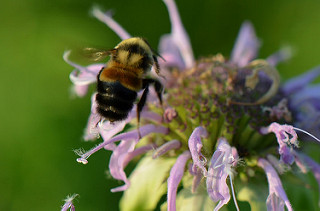The legal fight over sulfoxaflor, an insecticide used on a wide variety of crops, is expected to enter a new phase as EPA tries to give itself enough time to complete endangered species assessments and environmental groups continue pushing to ban the product.
In a December opinion, the 9th U.S. Circuit Court of Appeals gave EPA six months to consult with federal wildlife agencies about the impacts of sulfoxaflor on endangered species.
But since then, the parties to the case have been unable to agree about what the court meant when it said EPA should evaluate the effects of the insecticide on endangered species and “complete the (Endangered Species Act) … consultation requirements” in 180 days.
EPA is insisting that it is bound only to begin the consultation process, which the agency says it did by issuing a biological evaluation last week. In it, the EPA found the insecticide is jeopardizing the existence of 63 species listed under the ESA. Environmental groups are continuing to call for the product to be removed from the market and say the final BE only confirms their views.
Full interagency consultations required by the ESA can take a year or more, and EPA told the court in a motion for clarification that it assumed its order meant the agency just had to start consulting. EPA asked the court to clarify that its order means what EPA thinks it means. Otherwise, the agency said, it would ask for a rehearing.
Environmental groups and beekeepers disagree. They are expected to ask for a rehearing of their own on April 10 — the deadline for requests set by the appeals court — so they can continue asking to end the insecticide's registration. The court declined to do that in December because, it said, alternative products have more troubling toxicological profiles and removing sulfoxaflor would be disruptive for producers.
 The Rusty patched bumblebee is among the species discussed in the court and regulatory battle over the use of sulfoxaflor.
The Rusty patched bumblebee is among the species discussed in the court and regulatory battle over the use of sulfoxaflor.
Meanwhile, there is the matter of EPA’s latest evaluation, which it touted for concluding that the continued existence of only 4% of listed species would be “jeopardized,” as defined by the ESA, and only 3% of their critical habitat would be “adversely modified.” Those figures are down from 7% and 4% in the draft biological evaluation, which did not consider mitigation measures proposed by registrant Corteva Agriscience.
But to the Center for Food Safety and Center for Biological Diversity — the petitioners in the 9th Circuit action along with the American Beekeeping Federation and an individual beekeeper — the number of species facing jeopardy is still significant at 63, including 14 insects such as the Rusty-patched bumble bee and the Valley elderberry longhorn beetle, as well as 49 plants. In addition, they note that EPA concluded the chemical is likely to harm an additional 462 endangered species, including 314 plants.
EPA noted that a “likely to adversely affect” determination applies when even an individual member of a species is at risk, and there is no guarantee that in the final biological opinions issued by the wildlife services, the EPA determinations will turn into the more-serious jeopardy calls.
Under the ESA, the biological opinions include mitigation measures to avoid jeopardy as well as any harm to individual species.
EPA said it’s still discussing the registration with Corteva; the company told Agri-Pulse that in addition to the proposed mitigation already submitted to EPA, it “is committed to taking appropriate steps to ensure that there is no jeopardy to listed species and their habitats are protected, while also helping ensure growers are able to use Isoclast (Sulfoxaflor) active products to protect the quality, health and viability of their crops.”
“Sulfoxaflor targets only certain insects, reducing impact on beneficial organisms like pollinators and insects that prey on other damaging pests,” a statement from Corteva said. “Sulfoxaflor not only protects against key pests, but also helps mitigate the development of resistance, and protects the quality, health, and economic viability of crops.”
The environmental groups, however, say that it’s time the chemical was taken off the market because of the damage to endangered species. In addition, the final biological evaluation calls sulfoxaflor highly toxic to honeybees “on an acute exposure basis” and says “other insect species show similar or greater sensitivity compared to honey bees. Sulfoxaflor is very highly to highly toxic to aquatic insects.”
Don’t miss a beat! It’s easy to sign up for a FREE month of Agri-Pulse news! For the latest on what’s happening in Washington, D.C. and around the country in agriculture, just click here.
George Kimbrell, CFS legal director, said the fact that EPA has found sulfoxaflor is jeopardizing 63 listed species is enough to justify vacating its registration.
 George Kimbrell, CFS
George Kimbrell, CFS
“We're talking about species that are already on the verge of extinction, and they have to have priority,” he said.
He also cited the dissent by Circuit Judge Eric Miller, who said, “When a court determines that an agency has erred, the normal practice is to vacate the agency’s action.”
Miller said EPA’s “serious errors” in evaluating the risks to both bees and beekeepers “have raised correspondingly serious questions about its decision.” The agency’s approach to beekeepers “was one of thorough disregard,” he said.
In 2015, the appeals court vacated EPA’s approval of sulfoxaflor because Dow — the precursor to Corteva Agriscience — hadn’t provided enough evidence to show the product would not harm honeybees.
“After Dow (now Corteva) agreed to limit the type and scope of usage for sulfoxaflor, EPA in 2016 greenlit it for ‘limited uses’ even without additional studies,” the court said in its December decision. “Then in 2019, EPA made a surprise announcement that it had reviewed additional studies provided by Dow and had given ‘unconditional approval’ for sulfoxaflor on various usages that it had earlier canceled.”
The product is registered for a variety of crops, including: alfalfa, corn, soybeans, cotton, wheat, vegetables and ground fruit (such as tomatoes and lettuce), citrus, pome fruit, and rice.
For more news, go to www.Agri-Pulse.com.


